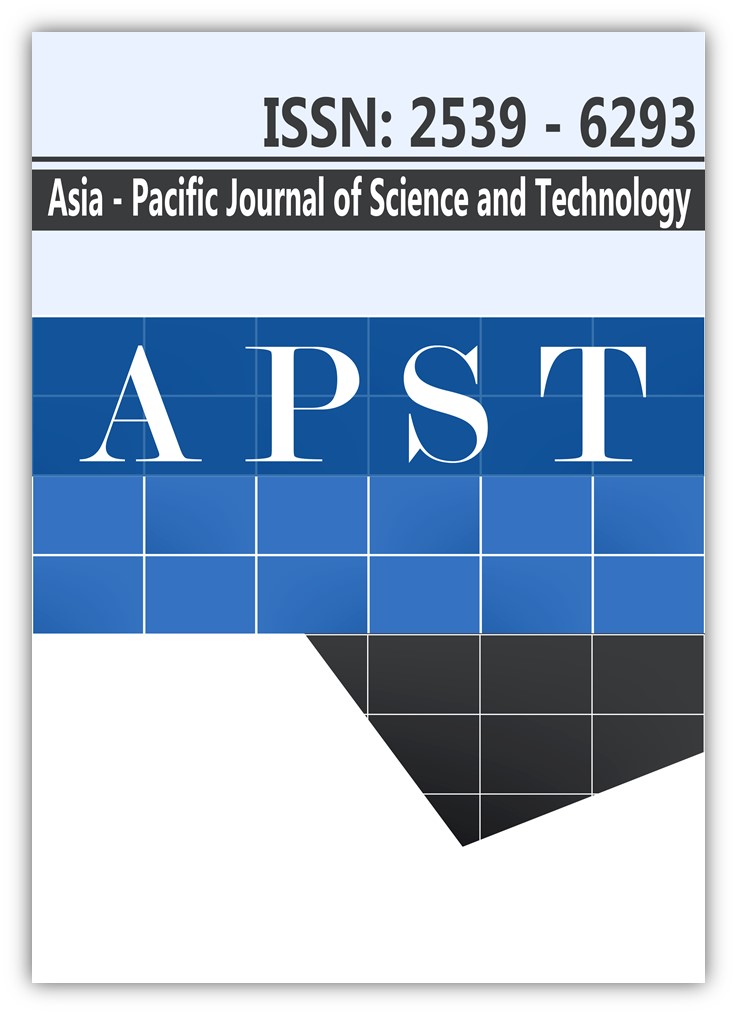Properties of composite film from tomato extracted pectin/ chitosan for use in sausage wrapping
Main Article Content
Abstract
This study investigated the properties of pectin/chitosan film (2% w/v of the pectin and chitosan) in 5 pectin/chitosan ratios: 100:0, 75:25, 50:50, 25:75, and 0:100. The findings suggest that decreasing the pectin proportion likely results in increases in certain properties of the film, including moisture content, water vapor permeability, and lightness (L*). Meanwhile, tensile strength, the red/green coordinate (a*), and the yellow/blue coordinate (b*) tend to be lower in response to the soluble pectin/chitosan composite film relative to the single-composite film. Additionally, the pectin/chitosan film could preserve sausage freshness for 9 d at refrigerator temperatures (4-5 °C) without an alteration in the original color of the sausage, as well as slow down the decline in pH levels and the growth rate of microbes.
Article Details
References
[2] Kusanteay D, Uriyapongson S. Effect of dried tomato pomace in concentrate diets on nutrient digestibility and growth performance of Thai native cattle. J Agr. 2016;32(2):261-271.
[3] Pornchalermpong P, Ratanapanon N. Pectin [Internet]. 2016 [cite 2018 Jul 5]. Available from: https://www.foodnetworksolution.com/wiki/word/0430/pectin
[4] Azeredo HMC, Morrugares-Carmona R, Wellner N, Cross K, Bajka B, Waldron KW. Development of pectin films with pomegranate juice and citric acid. Food Chem. 2016;198:101-106.
[5] Lorevice MV, Otini CG, Moura MR, Mattoso LHC. Chitosan nanoparticles on the improvememt of thermal, barrier, and mechanical properties of high- and low-methyl pectin films. Food Hydrocolloid. 2016;52:732-740.
[6] Saha NR, Sarkar G, Roy I, Rana D, Bhattacharyya A, Adhikari A, Mukhopadhyay A, Chattopadhyay D. Studies on methylcellulose/pectin/montmorillonite nanocomposite films and their application possibilities. Carbohyd Polym. 2016;136:1218-1227.
[7] Galus S, Lenart A. Development and characterization of composite edible films based on sodium alginate and pectin. J Food Eng. 2013;115:459-465.
[8] Perez CD, De’Nobili MD, Rizzo SA, Gerschenson LN, Descalzo AM, Rojas AM. High methoxyl pectin-methyl cellulose films with antioxidant activity at a functional food interface. J Food Eng. 2013;116:162-169.
[9] Espitia PJP, Avena-Bustillos RJ, Du W, Teofilo RF, Soares NFF, McHugh TH. Optimal antimicrobial formulation and physical-mechanical properties of edible films based on acai and pectin for food preservation. Food Packaging Shelf. 2014;2:38-49.
[10] Khurana R, Singh K, Sapra B, Tiwary AK, Rana, V. Tamarindus indica pectin blend film composition for coating tablets with enhanced adhesive force strength. Carbohyd Polym. 2014;102:55-65.
[11] Otoni CG, Moura MR, Aouada FA, Camilloto GP, Cruz RS, Lorevice MV, Soares, NFF, Mattoso LHC. Antimicrobial and physical-mechanical properties of pectin/papaya puree/cinnamaldehyde nanoemulsion edible composite films. Food Hydrocolloid. 2014;41:188-194.
[12] AOAC. Official methods of the association of official analytical chemists. Association of Official Analytical Chemists. Washington D.C.; 2000.
[13] Su JF, Huang Z, Yuan XY, Wang XY, Li M. Structure and properties of carboxymethyl cellulose/soy protein isolate blend edible films cross linked by maillard reactions. Carbohyd Polym. 2010;79:145-153.
[14] ASTM. Standard test method for water vapor transmission of materials. E96. In: Annual Book of American Standard Testing Method. Philadelphia; 1995. p. 829- 836.
[15] ASTM. Standard test method for tensile properties of thin plastic sheeting. D882. In: Annual Book of American Standard Testing Method. Philadelphia; 1997. p. 519- 527.
[16] TACFS 6000-2004. Pork. Thai Agricultural Commodity and Food Standard, Thailand Ministry of Agriculture and Cooperatives, Bangkok, Thailand; 2004.
[17] TISI 330/2004. Pork sausage. Thai Industrial Standards Institute, Thailand Ministry of Industry, Bangkok, Thailand; 2004.
[18] Jirukkakul N. A study of Mu Yor sausage wraps using chitosan films in corporating garlic oil, lemon grass oil and galangal oil. Int Food Res J. 2013;20(3):1199-1204.
[19] Raimondi S, Nappi MR, Sirangelo, TM, Leonardi A, Amaretti A, Ulrici A, Magnani R, Montanari C, Tabanelli G, Gardini F, Rossi M. Bacterial community of industrial raw sausage packaged in modified atmosphere throughout the shelf life. Int J Food Microbiol. 2018;280:78–86.
[20] Hamdi M, Nasri R, Dridi N, Moussa H, Ashour L, Nasri M. Improvement of the quality and the shelf life of reduced-nitrites turkey meat sausages incorporated with carotenoproteins from blue crabs shells. Food Control. 2018;91:148-159.
[21] Pitak N, Rakshit SK. Physical and antimicrobial properties of banana flour/chitosan biodegradable and self sealing films used for preserving Fresh-cut vegetables. LWT-Food Sci Technol. 2011; 44(10):2310-2315.


